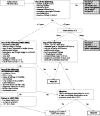Concussive head injury in children and adolescents related to sports and other leisure physical activities
- PMID: 16432005
- PMCID: PMC2492044
- DOI: 10.1136/bjsm.2005.021220
Concussive head injury in children and adolescents related to sports and other leisure physical activities
Abstract
Objective: To compare the characteristics of children and adolescents with concussive head injury (CHI) sustained during organised sports or other leisure physical activity.
Methods: This was a case series study reviewing the medical records retrospectively over a four year period of children 6-16 years presenting to the emergency department with a CHI after participating in sport and/or recreation activity.
Results: There were 592 cases of sport and recreation related concussion over the study period (2000-2003). Most of the patients (n = 424, 71.6%) were male, with half (n = 304, 51.4%) being older than 10 years of age. A total of 152 (25.7%) cases of CHI were related to playing sports. Most cases (71.2%) were mild concussion. The cause of injury was a fall (n = 322, 54.4%) or a collision. Nearly a quarter of the children (n = 143, 24.2%) were admitted to hospital, with imaging performed in 134 (22.7%). Most children were treated appropriately and no adverse events were reported.
Conclusions: A severe CHI in a child is six times more likely to have resulted from organised sport than from other leisure physical activities. Outcomes for CHI in children is excellent, although their management places a considerable burden on emergency services. The need for activity restriction and the benefits of this in reducing long term cognitive effects of CHI are uncertain.
Conflict of interest statement
Competing interests: none declared
Similar articles
-
An investigation of the effects of sports-related concussion in youth using functional magnetic resonance imaging and the head impact telemetry system.J Vis Exp. 2011 Jan 12;(47):2226. doi: 10.3791/2226. J Vis Exp. 2011. PMID: 21248710 Free PMC article.
-
American Medical Society for Sports Medicine position statement: concussion in sport.Br J Sports Med. 2013 Jan;47(1):15-26. doi: 10.1136/bjsports-2012-091941. Br J Sports Med. 2013. PMID: 23243113 Review.
-
On-field management and return-to-play in sports-related concussion in children: Are children managed appropriately?J Sci Med Sport. 2016 Mar;19(3):194-199. doi: 10.1016/j.jsams.2015.02.009. Epub 2015 Feb 24. J Sci Med Sport. 2016. PMID: 25772997
-
Sex-Based Differences in Symptoms With Mouthguard Use After Pediatric Sport-Related Concussion.J Athl Train. 2021 Nov 1;56(11):1188-1196. doi: 10.4085/1062-6050-0393.20. J Athl Train. 2021. PMID: 33848349 Free PMC article.
-
Sport-related structural brain injury associated with arachnoid cysts: a systematic review and quantitative analysis.Neurosurg Focus. 2016 Apr;40(4):E9. doi: 10.3171/2016.1.FOCUS15608. Neurosurg Focus. 2016. PMID: 27032926
Cited by
-
Repetitive concussions in adolescent athletes - translating clinical and experimental research into perspectives on rehabilitation strategies.Front Neurol. 2015 Apr 2;6:69. doi: 10.3389/fneur.2015.00069. eCollection 2015. Front Neurol. 2015. PMID: 25883586 Free PMC article. Review.
-
The International Olympic Committee (IOC) consensus statement on periodic health evaluation of elite athletes: March 2009.J Athl Train. 2009 Sep-Oct;44(5):538-57. doi: 10.4085/1062-6050-44.5.538. J Athl Train. 2009. PMID: 19771295 Free PMC article. No abstract available.
-
Concussion-Like Symptoms in Child and Youth Athletes at Baseline: What Is "Typical"?J Athl Train. 2016 Oct;51(10):749-757. doi: 10.4085/1062-6050-51.11.12. Epub 2016 Nov 11. J Athl Train. 2016. PMID: 27834505 Free PMC article.
-
The Clinical Utility of the Child SCAT5 for Acute Concussion Assessment.Sports Med Open. 2022 Aug 13;8(1):104. doi: 10.1186/s40798-022-00499-8. Sports Med Open. 2022. PMID: 35962887 Free PMC article.
-
An investigation of the effects of sports-related concussion in youth using functional magnetic resonance imaging and the head impact telemetry system.J Vis Exp. 2011 Jan 12;(47):2226. doi: 10.3791/2226. J Vis Exp. 2011. PMID: 21248710 Free PMC article.
References
-
- Cantu R C. Head and spine injuries in youth sports. Clin Sports Med 199514517–531. - PubMed
-
- Poirier M P. Concussions: assessment, management and recommendations for return to activity. Clin Pediatr Emerg Med 20034179–185.
-
- Poirier M P, Wadsworth M R. Sports‐related concussions. Pediatr Emerg Care 200016278–283. - PubMed
-
- Kraus J K. Epidemiological features of brain injury in children: occurrence, children at risk, causes and manner of injury, severity and outcomes. In Braman S, Michel M, eds. Traumatic head injury in children. New York: Oxford University Press, 199522–38.
Publication types
MeSH terms
LinkOut - more resources
Full Text Sources
Medical

